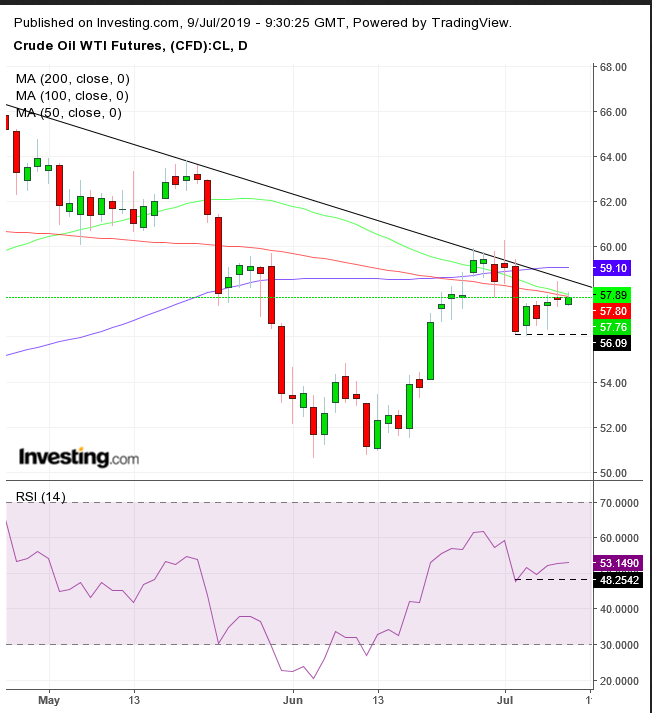The inability of oil prices to rally despite escalating tensions with Iran demonstrates just how bearish the commodity's investors are right now, given the high global inventories and concerns of an economic slowdown.
Not even the fallout from the U.K.'s seizure of an Iranian supertanker filled with illegal oil exports under sanctions to Syria seems to have overshadowed these fears. Tehran called it an act of piracy, a “threatening act.” The clash exacerbates the risk of military escalation in the region, any hint of which could push oil prices up and fast. Yet thus far, investors seem unimpressed.
Iran was the twelfth largest crude oil exporter in 2014, according to World Factbook, shipping 1,342,000 barrels a day. By 2018, Iran more than tripled exports to 4,470,000 barrels per day. This bumped it up to the world’s sixth biggest producer, making up 4% of the market, according to the U.S. Energy Information Administration, and filling Iran's coffers with cash.
U.S. President Donald Trump doesn’t look too kindly on this and intends to reverse this leap of the country’s top export and primary source of income. Removing 4% of oil in the market should providedramatic boost to oil prices, but that hasn't happened.
Elevated inventories and concerns about economic growth are putting a serious damper on demand. Oil investors are probably also waiting for Fed Chair Jerome Powell to say something, anything, that would reveal the U.S. central bank’s thoughts on the trajectory of rates after Friday’s job creation shocker — which provides the Fed with an excuse not to be as accommodative as the market demands.

Crude prices have been overshadowed by the 4.8% plunge a week ago, as the weakening global economy offset OPEC cut extensions and a U.S.-Iran face-off. Prices have managed to pare about half those losses in the week since.
The price is now retesting the 200 DMA after failing to overcome it on Monday. The 50 DMA has been falling toward the 200 DMA and is threatening to slip below it, triggering a Death Cross, right underneath the medium-term downtrend line since April 23.
A fall below last Tuesday’s low would form the second required trough needed for a short-term downtrend. The RSI shows how close it is to penetrating its previous low in forming that second trough.
Of course, any positive development for the outlook of demand, such as Powell’s reiteration of his dovish stance since January or any progress on U.S.-China trade talks might be what investors need to jump above $60 and reverse the trajectory. However, till then, prices are likely to slide as the outlook for falling demand manages to muffle the effect of the Iran sanctions and heating tensions with the country.
Trading Strategies
Conservative traders would not short oil, even after the short term joins the falling medium term, as the long term since the 2016 bottom is still up. They would go long after the short and medium terms synchronize with the long-term uptrend, after the price ticks above April’s high of $66.60.
Moderate traders may short with a close below $56, last week’s low, or go long above $60, when the medium-term trend posts a second peak to complete an ascending peak-trough pattern.
Aggressive traders may short at will — taking advantage of the price’s proximity to resistance, which offers an attractive risk-reward ratio — on the pessimism that persists, despite the geopolitics that should have boosted prices, relying on the medium-term downtrend line, along with the 200 DMA and the 50 DMA’s threat to cross below the 200 DMA.
Short Trade Sample
- Entry: $58.30
- Stop-Loss: $ 60.30, above July’s high
- Risk: $2
- Target: $52.30
- Reward: $6
- Risk-Reward Ratio: 1:3
